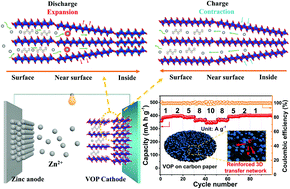Shallow-layer pillaring of a conductive polymer in monolithic grains to drive superior zinc storage via a cascading effect†
Abstract
Aqueous Zn metal batteries (ZBs) have obtained increasing attention recently owing to their low-cost and environmentally friendly nature. Unfortunately, the sluggish Zn2+ de/intercalation in hosts often requires the nanostructural tailoring of cathode materials, which however degrades the tap density and accelerates the dissolution of active species. Herein, we propose a shallow-layer pillaring strategy to drive the superior zinc storage performance of V2O5 monolithic grains without the prerequisite of intentional nanoscale attenuation. The in situ polymerized 3,4-ethylenedioxythiophene chains only in the near-surface V2O5 interlayers are sufficient to activate a cascading effect to successively open the deeper interlayers during Zn intercalation. This synergic interlayer expansion mechanism leads to a thorough and quick redox process of bulk phase V2O5 even with micro-sized grains as opposed to the poor reaction kinetics in the non-pillared one. In contrast to excess pillaring or cation doping, the shallow-layer hybridization with a hydrophobic conductive polymer can suppress the dissolution of active species, reinforce the conductive contact between grains, lower the Zn2+ diffusion barrier (0.39 eV) and absorption energy (0.17 eV), and upgrade the pseudocapacitance contribution (>67%) and Zn2+ diffusion coefficient (1.43 × 10−9–1.81 × 10−8 cm2 s−1). This composite cathode enables an unprecedented cycling/rate performance (e.g. 388, 367 and 351 mA h g−1 even at 5, 8 and 10 A g−1 respectively, and 269 mA h g−1 after 4500 cycles at 10 A g−1), corresponding to high energy densities of 280.2 and 205.8 W h kg−1 under ultrahigh power densities of 700.5 and 5960 W kg−1, respectively. This concept of shallow-layer pillaring activation (especially via rich organic molecules) can be extended to more electrode systems with the preservation of the grain integrity.



 Please wait while we load your content...
Please wait while we load your content...